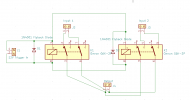I didn't see the grounds referenced at all. You should have the grounds all tied to a single point except for the +12V ground, as mentioned above, and you should then make a ground pour across the entire PCB (except for the screw mounting holes for the PCB) which is connected only to that central ground point and nothing else. A two sided PCB would easily do it, or even a single sided one for that matter. A double sided board would allow you to get complete ground plane coverage in land-locked areas by the use of vias. Are you etching the boards yourself or sending them out? I use
Advanced Circuits for my prototype boards, and they do a good job.
When tying the grounds of two components together you should pay attention to the potential of ground loops.

